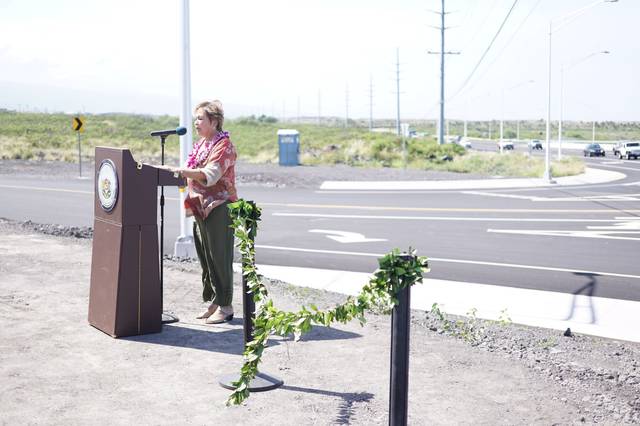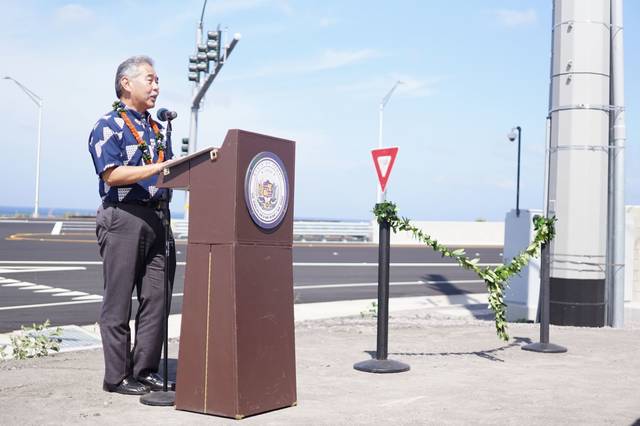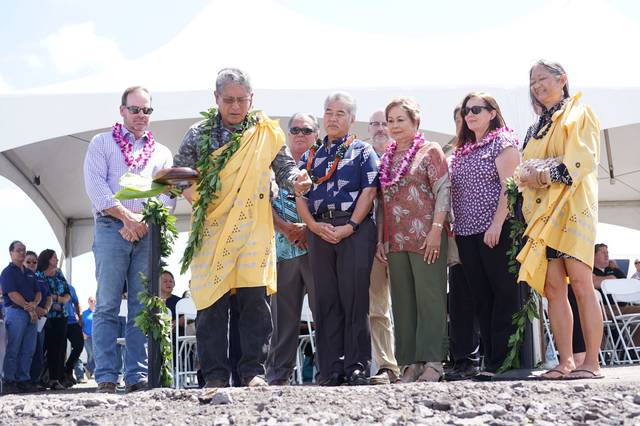KAILUA-KONA — As local officials celebrated the dedication of the newly widened stretch of Queen Kaahumanu Highway, the sound of horns from passing cars punctuated the speeches and remarks, notes of thanks — or at least, relief — for the completion of a project years in the making.
Three years after breaking ground and more than 10 years since the state first awarded a bid for the project, the highway now spans four lanes of north- and southbound traffic for a little more than 5 miles between Kealakehe Parkway and Keahole Airport Road.
“Even though we blessed this three years ago, we prayed every day that this would be completed,” said kahu Daniel Akaka Jr., who provided the blessing Thursday and at the 2015 groundbreaking. “So this is a happy day for all of us, this community and for the Island of Hawaii.”
Thursday’s ceremony officially marked the $121 million project as “substantially complete,” with some work, such as landscaping and signage installation, still remaining.
Motorists driving through the area will likely notice the use of ’a’a in the median. Donald Smith, Hawaii District engineer with the state Department of Transportation Highways Division, said the use of ’a’a isn’t just for aesthetics, it’s also low-maintenance and discourages motorists from attempting to cut across the median.
And for those who have worked to push the widening project forward, Thursday’s dedication was cause for celebration.
“The area north of Kona, the area that this portion of the Queen Kaahumanu Highway services, is a great example of the best that Hawaii state and Hawaii Island has to offer,” said Gov. David Ige in remarks to the crowd. “Scenic views, a connection to the history of the people of the first nation of Hawaii, our second international air point-of-entry at Ellison Onizuka Kona International Airport and really an example of technical, environmental and cultural innovations coming together to make a difference for our community.”
Ige added that ensuring continued support of state infrastructure in the region “will continue to be one of my priorities.”
In addition to widening the highway from two to four lanes throughout the project area, Ed Brown, Hawaii vice president of operations for Goodfellow Bros. Inc., noted that the effort also resulted in six new signalized intersections, as well as 4.5 miles of new water lines. It also resulted in a new sewer system to move water from regional developments to the Kealakehe Wastewater Treatment Plant and an R-1 line to bring back treated water.
“This team, our work family, has taken on lots of obstacles and has endured tough hurdles,” said Brown. “Regardless of that, we always had the goal to build the best, safest, long-lasting and highest-quality road for the community.”
Brown said more than 210,000 man-hours went into the project, noting that all workers, including construction crews, come from Hawaii Island.
“What was created is a state-of-the-art travel way that is not only to meet the demands of today but is built for the future,” he said.
Local lawmakers, too, celebrated the milestone, including state Rep. Nicole Lowen, who told the crowd that the project was likely the No. 1 topic of phone calls to her office from constituents over the last few years.
“So it’s just really exciting that all the lanes are open,” she said. “Traffic is moving smoothly.”
It was also cause for celebration for state Sen. Lorraine Inouye, who was Hawaii County’s mayor in 1991 when then-Gov. John D. Waihee III and then-DOT director Edward Y. Hirata came to her with the original plans to widen Queen Kaahumanu Highway.
“You would not believe how things have changed from the first plan that I saw,” she said, sharing that the original proposal included on-ramps and off-ramps.
The first phase of the widening project would eventually break ground in September 2005 during the Lingle Administration and be dedicated in spring 2009.
Now, as senator, Inouye chairs the Senate Committee on Transportation and Energy.
“It’s just to show you how long it takes to get a project of this magnitude,” said Inouye.







WELL THE COMPLETION is VERY welcomed. “Three years after breaking ground” are you sure this fact is correct? Sure seems longer than that, as I believe it was 2012 when the first “X” highway started? An I betr 121M is a low figure when the dust settles. Seems expensive for 8-10 miles of straight Highway @ appros 12.1M per Mile? And as far as Ige goes, I don’t think this is “a great example of the best that Hawaii state and Hawaii Island has to offer” it is now functional and hopefully eases the Kona Crawl however I would think sitting my keester on the beach somewhere on our Island versus a road is the best the BI has to offer?
Phase I between Henry Street and the harbor started in 2006 and finished in 2009. Phase I
was 3.5 miles long and took 3 years to complete. Phase 2 is 5.2 miles long and roughly took
three years to complete.
Phase 2 was supposed to start in 2008 and finish in 2010, but three bid protests held up the project. Then a significant archaeological discovery by the Kaloko Honokohau NP ultimately held up construction again for almost 4 years. That discovery resulted in several Native Hawaiian Organizations and the National Park Service requesting a Section 106 consultation and revised archaeological inventory survey.
And what did we gain gain in the delay and from the survey? Please don’t say that we can all enjoy some rocks that may have been used to build an early village. 50 years from now the ocean will be covering most of that area and all will be lost again.
Federal law states that archaeological preservation is required to receive federal highway funds. Look up ACHP, Section 4(f), Section 106, and National Historical Preservation Act.
See and it has been rumopred that the bones found there were from the construction workers eating the 4.99 Costco Chickens and littering? That what they are saying on the street anyway.
As far as I understand, the site in question was found during the data recovery process before construction was supposed start in 2011. It was located close to the highway right of way by Kaloko-Honokohau National Park.
Yes but it doesn’t state that every little thing has to be preserved, something major ok, something trivial not ok.
The four year delay between 2011-2015 resulted in the median being reduced
between Hina-Lani Street and the Honokohau Boat Park Road. This was done preserve sites in the National Park from further destruction. As a result, the cost
increased over the course of the project to redesign this portion of the highway
to avoid these sites. Its also made it more difficult to widen this segment of highway going forward.
if the highway ever needs widening again, maybe they build extension overpasses….like that would ever happen here.
There was plans to include overpasses when the project was originally conceptualized in the early 1990s, but they were removed during the design process. The segment between the airport and Hina-Lani Street has adequate space to widen the highway, along with segment between Kealakehe Parkway and Henry Street. However, the segment between Kealakehe Parkway and
Hina-Lani Street will be difficult to widen due to the Kaloko Honokohau National Park. HDOT/FHWA will have to redo the 4(f) process, especially since the entire National Park is included in the area of potential effect from this project.
I was being sarcastic in the overpass response We both know that would never happen on this island. Point is the historic site protection on this island is overly protective of useless land that may have had some ancient Polynesian walk across it to go someplace else. The policies prohibit or make it extremely difficult to build infrastructure while allowing shrinking ocean frontage to be privatized by resorts or luxury property builders. Thus shrinking the ability for locals to enjoy the last vestiges of their heritage seen in the heart’s of the first visitors, open waters and Sandy Beaches. If you want to protect something protect those.
Odd this sounds like an excuse explation. It still took too long and way to much money for what we got. Christ man when should have gotten a suspension bridge thrown in there too!
Highway construction in Hawaii isn’t cheap. Its extremely costly due to environmental/archaeological regulations, the rough environmental conditions,
and higher cost for labor and materials.
Part of the reason construction costs are more here is due to graft which needs to be addressed. And all the regulatory issues should be addressed prior to starting construction the starting and stopping adds to costs. It’s poor management that adds costs to project. Its not like these supposed finds are something new here.
Do you have evidence that graft plays a role in higher construction costs, or are just talking out of one side of your mouth?
Queen Kaahumanu Highway widening Phase 2 was supposed to cost 66 million dollars back in 2006. The bids were in the mid 70s to low 80s throughout the three rebids. Goodfellow’s final low bid in 2010 was 77.2 million, but due to a four year delay the costs rose to low 90s. The costs increased to 105 million, 121.3 million and 128.1 million due to project change orders during the course of the three year project.
The original archaeological survey was done in 1995. HDOT relied on that AIS and EA, which was completed in 1996 to go forward with the project. HDOT’s consultant conducted data recovery through the project before construction was supposed to start in 2011. The consultant found a archaeological site nea rthe right of way. This caught the attention of the National Park Service, and ultimately several Native Hawaiian Organizations. HDOT and FHWA had to conduct a 4 year Section 106 consultation as result.
Yes when we spring it we will put you on the supeona. What I can say is the info comes from vendors and equipment people.
I will reject any subpoena issued by you, as I believe you’re full of hot air. You can’t even tell me any specific examples of graft.
Won’t be coming from me. This case was referred to the FEDs under the Fraud, Waste and Abuse and Whistle Blower Statutes. It started due to one of the suppliers/contractors that came over from the mainland to correct a construction issue was speaking about what was going on at an bar. They thought they were speaking with a friendly but they were not. Contact information was exchanged and then turned over to the feds and has been started on the mainland. My guess this has not even hit our state yet. You see there is great bounty in whistle blowing. And based on your posts I am sure they are watching articles like this one and will be in contact with a sympathizer who feels it OK to commit fraud against his fellow citizens.
I don’t feel it is OK to commit fraud against fellow citizens. Get your facts straight. I’ve spent over the last 10 years following this particular project. The last three years I remained in contact with the contractor to get monthly updates. What have YOU done?
You really need to look the mirror, as you’re throwing unfounded accusations against me, the HDOT, FHWA, and contractor.
We will agree to disagree since my factsd are fine. I am sure your are correct as well. Merry XMas
Agreed. NOT cheap. Perfectly logical.
But, from what I can tell, subjectively, not quality either.
Hell, there are bituminous pack roads in Wisconsin (wisely recognized as having one of the best secondary road systems in the nation) that are closing in on their hundredth birthday.
Harsh weather? Freezing? Thawing? 100 degree summer days?
Roads still seem to last longer.
Technology or labor? I won’t speculate.
Just like the CONTINUAL “water main” breaks on Oahu. Mostly Honolulu, it seems.
No comparison.
Something is wrong here.
Just like having the MOST government workers per capita. Something is wrong. We simply are not that efficient here. I’m incompetent, even.
I’m speaking as a former government employee. Twenty years federal/state/county.
We got trouble with a capital “T” and it rhymes with “P” and that stands for Public Employees.
Just saying.
Queen Kaaumanu Highway? Private contractors. In this case.
Let’s see how long it lasts.
Hopefully longer than Honolulu’s water mains.
you mean I don’t have to wait one hour to drive twelve miles. I guess that’s worth a 121 million for 12 miles. I guess under the black top pavement must be lined with Gold and silver and a whole lot of Ben Franklins.
Phase 1 was roughly 45.9 million for 3.5 miles (Completed in 2009; construction started in 2006)
Phase 2 cost 128.1 million dollars for 5.2 miles (Completed in 2018, construction started in 2015)
Thank you to our Political Leaders for completion of the Queen Kaahumanu highway project. But let’s not stop here. The stretch from the Airport to South Kohala is extremely dangerous. Start planning to build 4 lane highway all the way to the Harbor.
Beautiful it’s done Now enforce the speed limits on it. People already going 50% faster than posted speeds it will be a death trap to many who feel angelic while behind the wheel
Wait till the boozed up tourists off the planes get in their Mustangs get on that thing!
not the tourists I’m worried about it usually a hyped up local flying to work or back that’s behind the accidents.
Interesting.